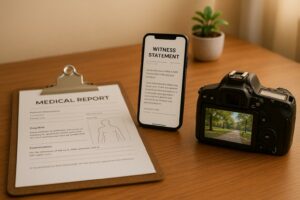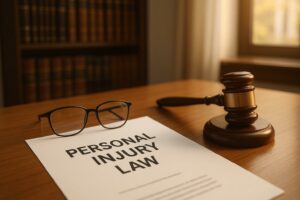When pursuing a dog bite claim, evidence is everything. To secure compensation and prove liability, you need solid proof of what happened and how it affected you. Here’s a quick rundown of the types of evidence that can strengthen your case:
- Medical Records: Hospital reports, treatment details, and bills to show the extent of your injuries and costs.
- Injury Photos: Clear, dated pictures of wounds and scars to visually document the harm done.
- Scene Evidence: Photos of the location, damaged items, and anything that highlights negligence (e.g., broken fences).
- Witness Statements: Testimonies from people who saw the incident or know the dog’s history.
- Official Records: Animal control reports, police citations, or prior complaints about the dog.
Act fast to collect this evidence. Every detail matters when building a strong case. If you’re unsure where to start, legal experts can help ensure no critical piece of evidence is missed.
Medical Documentation
Medical records play a key role in supporting your dog bite claim by providing evidence of your injuries and their impact.
Hospital and Doctor Records
Hospital and doctor records serve as primary evidence in your case. These documents often include:
- Initial trauma assessments that detail the extent of the injuries.
- Descriptions and measurements of the wounds.
- Treatment procedures performed, such as cleaning or stitching the wounds.
- Prescribed medications for pain management or infection prevention.
- Follow-up care instructions to ensure proper healing.
Additionally, medical bills and receipts highlight the financial burden caused by the incident. For instance, in a 2023 case, thorough medical documentation helped secure compensation of $45,000.
Injury Photos
Photographs are crucial for showing the severity of the injuries and tracking the healing process. When documenting injuries:
- Take clear, well-lit photos as soon as possible after the incident.
- Include close-up shots to highlight wound details.
- Use a reference object like a ruler or coin to provide scale.
- Capture multiple angles of the injury for a complete view.
- Continue taking photos over time to document healing progress and any lasting scars or disfigurement.
These visuals provide undeniable proof of the physical harm caused by the attack.
Mental Health Records
Emotional trauma is just as important to document. Mental health records can include:
- Psychological evaluations, therapy notes, and diagnoses for conditions such as PTSD, anxiety, or depression.
- Treatment plans that outline steps to address emotional or psychological distress.
Keeping a personal journal can further support your claim. Record details about your pain, disruptions to daily life, emotional changes, and how you respond to treatment.
If you’re unsure how to collect and present medical documentation effectively, working with legal experts like those at Ocala Injury Law can provide valuable guidance. Up next, we’ll explore how scene evidence can strengthen your case even further.
Scene Evidence
Scene evidence helps establish the where and how of a dog bite incident, laying the groundwork for determining liability and identifying safety lapses. To build a strong case, it’s crucial to document the scene with photos and physical items that capture key details.
Location Photos
Take photos of the location where the incident occurred to provide a clear picture of the surroundings. Be sure to include:
- Property boundaries that show where the event took place
- Containment features like fences, gates, or kennels
- Warning signs (or the lack of them)
- Lighting conditions that might have influenced visibility
- Environmental factors, such as broken fencing or obstructive objects
These photos help paint a complete picture of the setting, which can be critical in demonstrating negligence or unsafe conditions.
Physical Items
Physical evidence can further illustrate the impact of the incident. Be sure to document and preserve items such as:
- Torn or bloodstained clothing worn during the attack
- Damaged personal belongings, like phones, glasses, or bags
- Medical devices used immediately after the bite, such as bandages or tourniquets
- Protective equipment worn at the time, if applicable
To ensure this evidence is useful:
- Photograph items immediately: Capture their condition before moving them.
- Store carefully: Use sealed bags or containers to prevent deterioration.
- Log details: Note exactly where each item was found and its condition.
- Track handling: Maintain a chain of custody by recording who has handled the evidence.
Preserving scene evidence can make all the difference in a legal case. For example, Ocala Injury Law recently handled a dog bite case where torn clothing with visible bite marks played a key role in securing fair compensation for the victim’s injuries and losses.
Witness Statements
Witness statements play a crucial role in backing up your account of a dog bite incident. These firsthand accounts provide a clear picture of what happened, helping to establish the sequence of events and shedding light on the dog’s behavior before, during, and after the attack.
Direct Witnesses
Testimonies from direct witnesses bring an unbiased perspective to the situation, supporting the victim’s version of events. These witnesses could include:
- Passersby who saw the attack unfold
- Neighbors who were present during the incident
- First responders who arrived at the scene
- Good Samaritans who stepped in to help
When gathering witness information, make sure to:
- Write down their contact details, including full name, phone number, and address
- Collect their statements as soon as possible to ensure accuracy
- Ask for specific observations about the dog’s behavior and the owner’s actions
- Note the exact time and location of the attack
Witnesses who can also speak to previous encounters with the dog can add even more weight to your case by showing a pattern of behavior.
Prior Incidents
Statements about earlier incidents involving the dog can highlight a history of aggression, which may prove the owner was aware of the risk. These accounts might come from:
- Mail carriers or delivery workers who regularly interact with the dog
- Neighbors who know the dog’s past behavior
- Others who have seen or experienced similar incidents
In past cases, Ocala Injury Law has successfully used witness statements about prior aggressive behavior to establish a pattern. Be sure to gather details like dates, descriptions of the dog’s actions, any official reports, and evidence of warnings given to the owner.
The most effective witness statements focus on specific details rather than vague impressions. For instance, instead of saying the dog "seemed aggressive", a stronger statement would describe how "the dog lunged at people, bared its teeth, and growled multiple times." These vivid details can significantly strengthen your claim.
sbb-itb-68ed374
Official Records
Official records play a crucial role in dog bite cases, offering documented evidence of a dog’s behavior and the owner’s failure to address known risks. These records are valued because they provide clear, third-party proof that’s hard to dispute.
Past Attack Reports
Reports from animal control or the police establish a detailed timeline of a dog’s aggressive behavior. They typically include:
- Descriptions of incidents, along with dates and locations
- Actions taken by authorities
- How the owner responded
- Witness information
The value of these reports lies in their impartiality and thoroughness. For instance, if animal control has documented several incidents of aggression over a short period, it becomes clear that the owner was aware of their pet’s dangerous tendencies.
Legal Citations
Legal citations for violating local safety ordinances can highlight an owner’s negligence. These might include:
- Violations of leash laws or improper containment
- Failure to register or vaccinate the dog
- Details like dates, owner responses, repeat offenses, and escalating penalties
| Record Type | Evidence Value | Impact on Case |
|---|---|---|
| Animal Control Reports | Logs previous attacks or complaints | Shows the owner’s knowledge of aggression |
| Police Citations | Documents ordinance violations | Establishes a pattern of negligence |
| Warning Notices | Proves the owner was notified of risks | Confirms awareness of potential dangers |
Timing is key when it comes to gathering these records. Request them as soon as possible after the incident, as many are only retained for a limited time. Partnering with experienced legal professionals, like the team at Ocala Injury Law, can ensure you obtain all the necessary documentation.
When combined with medical records and witness statements, official records help create a comprehensive timeline of events. Together, they solidify your case by supporting your account and reinforcing every aspect of your claim.
Conclusion
Building a strong dog bite case hinges on carefully gathering and presenting evidence. This includes thorough medical records, detailed photographs, witness accounts, and official documentation – all working together to establish liability and support compensation claims.
Medical records and photos provide clear proof of the injuries and their progression. Witness statements and official reports add context to the incident, potentially highlighting any history of aggression and negligence.
Acting quickly to document injuries and gather witness information is critical. The sooner these details are collected, the stronger the case becomes.
At Ocala Injury Law, we know how to piece together every element of evidence to strengthen your claim. From medical reports to eyewitness accounts, we ensure that no detail is overlooked, helping you build a solid foundation for your case.
Thorough documentation is essential for securing compensation. Each piece of evidence contributes to showing the full extent of damages and ensuring victims receive the justice they deserve.
FAQs
What should I do right after a dog bite to collect important evidence for a legal claim?
If you’ve been bitten by a dog, acting quickly and wisely can make a big difference for your legal case. The first step is to seek medical attention right away. Not only is this essential for your health, but the medical records will also serve as key evidence if you pursue legal action.
While still at the scene, try to gather as much information as you can. Take clear photos of your injuries, the area where the incident happened, and the dog if it’s safe to do so. Be sure to get the contact details of the dog’s owner and any witnesses who saw what happened. Witness statements can play a big role in supporting your claim.
Lastly, make sure to report the bite to your local animal control or law enforcement agency. This ensures there’s an official record of the incident, which could be important down the line. For tailored legal advice and support, consider reaching out to an attorney experienced in dog bite cases, like Ocala Injury Law, to help protect your rights and guide you through the process.
How can I document emotional trauma from a dog bite, and why does it matter for my case?
Documenting Emotional Trauma After a Dog Bite
Recording emotional trauma after a dog bite is a key step that can influence the outcome of your case. While physical injuries are often more straightforward to prove, emotional impacts – like anxiety, depression, or PTSD – are just as significant and deserve attention.
Start by keeping a detailed journal of your emotions, thoughts, and daily struggles following the incident. This can serve as a personal record of how the trauma has affected your life. Seeking support from a licensed therapist or psychologist is also essential. Their professional documentation and potential testimony can provide compelling evidence of your emotional distress.
It’s also important to explain how the trauma has disrupted your daily life. For instance, you might experience trouble sleeping, avoid certain places, or notice changes in your relationships. These details help paint a clearer picture of the emotional toll.
By including evidence of emotional trauma, you present a more complete view of the harm you’ve endured. This can play a crucial role in securing fair compensation for both your physical and emotional suffering.
Why is it important to gather evidence quickly after a dog bite, and what risks come with delaying?
Acting promptly to gather evidence after a dog bite is essential for building a strong case. As time passes, critical details – like witness recollections, visible injuries, or environmental factors – can fade or become less reliable. For example, wounds might heal, making it more difficult to document the extent of your injuries, or witnesses may struggle to recall important aspects of the incident.
Waiting too long to collect evidence can weaken your claim, making it harder to prove liability or secure fair compensation. To strengthen your case, make sure to gather medical records, photos of your injuries and the scene, and statements from witnesses as soon as possible. If you’re unsure how to proceed, consulting an experienced attorney can provide the guidance you need to protect your rights.




